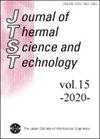热壁条件对脉动通道流动动量和换热差异性的影响
IF 0.9
4区 工程技术
Q3 THERMODYNAMICS
引用次数: 0
摘要
采用直接数值模拟(DNS)方法研究了等温差(CTD)条件和均匀热流密度加热(UHF)条件下的脉动湍流通道流动。本研究的主要目的是阐明脉动流动中动量传递和传热之间的差异是如何出现的,其中的差异可能源于CTD条件与速度场无滑移条件的不同,而不是源于脉动下的热流体物理。对稳态摩擦雷诺数Res = 300下的三种脉动频率进行了仿真。对比CTD和UHF条件下的相位平均量,发现无论热边界条件如何,近壁区温度振荡的频率依赖关系几乎是相同的,尽管时间平均温度分布不同。因此,在CTD和UHF条件下,斯坦顿数与摩擦系数的比值在脉动期间都发生了变化,这是类比的晴雨表。随着脉动频率的增加,振荡幅度增大。因此,证实了无论热边界条件如何,都存在差异。此外,湍流普朗特数表现出与斯坦顿数与摩擦因数之比相似的循环行为。组成湍流普朗特数各分量的时间变化表明,高频处差异增大主要是由于壁面附近的速度梯度振荡放大,由于近壁面涡结构不能跟随流动的快速变化,使得雷诺数剪应力和湍流热流密度保持在时间平均值附近。+ = 0.0044处,湍流脉动过程中涡结构和Nu分布变化较大;红色的高区域随着头发的粗度而变化本文章由计算机程序翻译,如有差异,请以英文原文为准。
Effect of thermal wall condition on the dissimilarity of momentum and heat transfer in pulsating channel flow
Pulsating turbulent channel flows under constant temperature difference (CTD) condition and uniform heat flux heating (UHF) condition are studied by direct numerical simulation (DNS). The main objective of the present study is to clarify how the dissimilarity between momentum transfer and heat transfer appeared in the pulsating flows, in which the dissimilarity may originate from the CTD condition dissimilar to the no-slip condition of the velocity field rather than from the thermo-fluid physics under pulsation. Simulations have been performed for three pulsation frequencies under the friction Reynolds number at steady-state, Re s = 300. Comparing the phase-averaged quantities under CTD and UHF conditions, it is found that the frequency dependence of the temperature oscillations in the near-wall region is almost the same regardless of the thermal boundary condition although the time-averaged temperature profiles are different. As a result, the ratio of Stanton number to friction factor, which works as a barometer of the analogy, changes during the pulsation period at both CTD and UHF conditions. Besides, the oscillation amplitude becomes larger as the pulsation frequency increases. Therefore, it was confirmed that the dissimilarity appears regardless of the thermal boundary condition. In addition, turbulent Prandtl number shows similar cyclic behavior to the ratio of Stanton number to friction factor. Time variations of each component constituting turbulent Prandtl number reveal that increasing dissimilarity at the high frequency is mainly attributed to the amplified oscillation of velocity gradient near the wall, where Reynolds shear stress and turbulent heat flux are kept at around the time-averaged values because the near-wall vortex structures cannot follow the rapid change of flow At + = 0.0044, vortex structures and distribution of Nu show a large change during flow pulsation; high region in red color changes with the coarse the do
求助全文
通过发布文献求助,成功后即可免费获取论文全文。
去求助
来源期刊
CiteScore
2.30
自引率
8.30%
发文量
0
审稿时长
5 months
期刊介绍:
JTST covers a variety of fields in thermal engineering including heat and mass transfer, thermodynamics, combustion, bio-heat transfer, micro- and macro-scale transport phenomena and practical thermal problems in industrial applications.

 求助内容:
求助内容: 应助结果提醒方式:
应助结果提醒方式:


